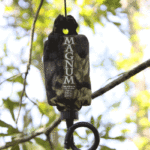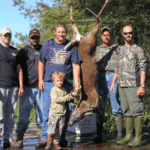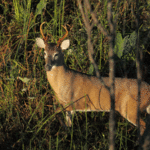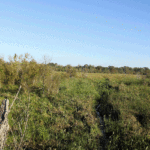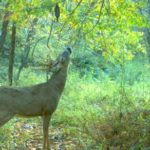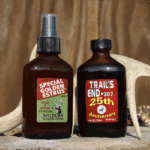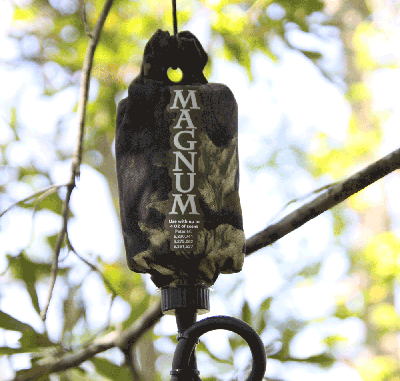
The effectiveness of deer attractant scents is hotly debated, but these hunters think they are important — at times.
As the story goes, Jake Spangler’s grandfather owned a meat market back during the depression years of the last century. Each Saturday the butcher would take an old man he knew a piece of meat just to help him out.
As time went on, the old man passed away. The kindness that Spangler’s grandfather showed didn’t go unnoticed, when he was willed property near Black Crook Bayou in St. Mary Parish that his family shares and hunts today.
Though Spangler’s grandfather didn’t do much with the property, his father Reid did and started hunting it, where eventually a family camp was built. And, the camp life growing up hunting deer with his father, uncles, cousins and friends is where Spangler said he came into his own.
Now 35, Spangler said growing up his dad didn’t have available to him some of the technology that’s out there today like trail cams, range finders, deer lures, cover scents and human scent-elimination products.
In fact, he said he learned and used more-natural “poor boy” methods to hunt deer, mainly because his father was so frugal.
“My dad started taking me deer hunting when I was 4 or 5 years old,” Spangler said, recounting his introductory years. “I remember him dragging me by the nape of neck some days to get me to the stand. And I was 12 years old when he started putting me in the stand by myself and when I killed my first deer. In fact I still have a stand where he and I hunted way back then. We called it ‘old faithful,’ because we’d kill a deer out of it every year.
“But, we’d walk everywhere, wearing our hip boots. Dad never believed in the modern technology and stuff like that, and over the years I hunted the hard way. When I started working for CLECO, I said there’s a better way to hunt and bought me an airboat to get around and break roads and trails, making it easier to see and hunt deer.”
Once Spangler got his equipment situated to better traverse his hunting property, he said he and his buddies began trying just about everything when it came to hunting whitetails to gain an advantage.
However, beyond trail cams and other electronic technology Spangler said when it came to scent products he felt they had their limitations. What’s more, in the region and terrain they all hunted, only under certain conditions were they effective.
Spangler said he tried to keep things natural and went so far as using the tarsal glands of a rutting buck, tying them to trees. He said they also tried to save the urine from does they harvested, but were never sure if they were in estrus.
“Usually if you’ve got a doe that’s hot, the urine from her will work in attracting bucks,” he said. “But, you don’t always know if she is hot in rut or not.
“I also find if you kill a good buck that’s in rut and take the glands off its hocks you can tie that off in a tree farther out from your stand to use that smell to attract a buck.”
However, he said such lures are only useful when employed correctly.
“How you’re hunting is one of the critical things about their effectiveness,” Spangler said. “We have areas where we might see a deer 200 or 300 yards away. I don’t find they work as well in those situations like they would in bow hunting situation when you’re using them to attract a deer in closer.
“That’s not to say anything bad about scents. But, out in open areas like the marsh you also have wind swirling around.”
Yet during a weekend hunting trip he invited me to share earlier this fall, camp buddy Nick Charpentier is a believer in commercial deer urines — particularly doe-pee in estrus, which he claims helped him harvest an 8-pointer only days prior.
“I was hunting an airboat road in the marsh that had a myrtle thicket in the back,” Charpentier said. “The wind was blowing right through me, coming from my back going out. I took the doe urine and sprayed it in the air, and the wind blew the smell away from me towards the thicket.
“I’d spray it every so often, and this big 8 came out of the myrtles with his nose in the air and I shot him when he walked towards me checking out the scent, I guess.”
In talking with Spangler, his deer-season preparations aren’t unlike anyone else’s. Though he hunts mostly marsh, terrain you invariably wouldn’t think of as being whitetail country when compared to bottomland hardwood swamps, piney woods, upland hardwoods and farm fields, he still looks for deer sign in the form of trails and rub lines like anyone and sets up near them.
Point of fact, the Louisiana marsh is like most other whitetail habitat, in that it does have canal banks, spoil banks, oak cheniers and adjacent grown-over levees where deer can stay dry, find cover, and find soft and hard mast food sources during the year.
Here is where the use of scents is as applicable as they would be in any other terrains throughout the state and country, for that matter.
Enter Ron Bice with Wildlife Research Center, which produces and makes lures, scents and urines to attract deer, as well as products to dispense them. Additionally, they also make products to eliminate human odors.
“Lures and scents are products that have been developed to enhance your hunting,” Bice said. “They’re not magic, but they do put the odds into your favor, where you’re going to be able to change the reaction of that deer because you put out a scent that is somewhat attractive to him.
“Mock scrapes are where you can actually create one by placing a dispenser above the ground, and it drips onto earth you’ve turned over or a natural scrape you’ve actually found and use.”
Hunters still have to scout out places where deer activity is present whether that’s in the marsh like where Spangler hunts, or in other regions as mentioned. Having hunted farm fields in southern Michigan and walked for woodcock on Louisiana WMAs such as Sherburne and Red River, as well as canal banks and levees in St. Mary Parish, I’ve always noticed deer rubs. What’s more, deer rub lines where I’ve found scrapes.
Like a feeder with a timer to spread corn or some other feed for deer in order to condition them into entering your kill zone, scent dispensers over a mock or natural scrape can condition a buck to become more active during the daylight hours, when you’re sitting on your stand.
“A buck can generally tell the freshness of a particular scent, and they want to intercept the other deer, like the hot doe or dominant buck that’s supposedly depositing on his scrape,” said Bice, who harvested a 161-inch buck in Minnesota in September while bow hunting. “And when using a dispenser he’s going to have to visit it during the day time to encounter that buck.
“What that’s doing is conditioning that scrape. So, it’s a really neat way to enhance hunting opportunities.
“Building a mock scrape can be really exciting, where a deer is working it as a natural scrape and then to getting multiple bucks working it. When that occurs you definitely put some major league odds in your favor.”
Wildlife Research has actually developed and patented a dispenser called “The Magnum Scrape-dripper” that releases scent when hunters are hunting. The dispenser incorporates an air pocket, and when filled with 4 ounces of any of the company’s recommended lures like “Golden Scrape” rising daytime air temperature rises increases pressure inside the dispenser, dripping fresh scent onto the scrape.
A buck will want to check the scrape when it’s fresh and when you happen to be in the stand.
Scent elimination is also extremely important. In the 1972 movie Jeremiah Johnson, mountain man “Bear Claw” Chris Lapp (played by Will Greer) says to Johnson (played by Robert Redford), “I know who you are; you’re the same dumb pilgrim I’ve been hearin’ for 20 days and smellin’ for three!”
Spangler, being all natural, is very conscientious about smells when it comes to hunting the marsh, but also other areas like Mississippi where he has hunted in the past.
“What I try to do — especially if we’re cooking and stuff — is I try to hang my clothes outside,” he said. “I don’t want the smells from inside the camp to be in my clothes. I let Mother Nature take over when I do that.
“But when I’ve hunted the hardwoods like up in Mississippi, I’ve used pine needles and pinecones and put them in a garbage bag and left them like that until my hunt. You can use different scents, but to me (in) the area you hunt you want smells that are natural to it.”
Bice recommended maximizing hunting opportunities by being pristine. In other words, being as scent free as possible, not only when hunting but when out preparing mock scrapes.
Spraying down with scent-killer products, as well as wearing rubber boots and rubber gloves, when preparing a mock scrape — as trappers do putting steel in the ground setting traps for predators — can help neutralize the odors you emit.
Bice said deer ultimately live and die by their noses; hunters who utilize scent-killer products in the field or the type you wash your clothes in and put on later all improve the odds when matching wits with a big buck.
Other products at a hunter’s disposal are curiosity scents. Spangler said young bucks and does, on occasion, have come down game trails he happened to be hunting and walked right up to his parked airboat and smelled it.
That’s not the norm, of course; hunters would be better off testing a few products available like Wildlife Research Center’s “Trails End# 307” or “Tink’s 69” to get a deer’s attention when other things don’t work.
Whether trying to do it naturally like Spangler has over the years or using today’s technology, no doubt compensating for a deer’s sense of smell by either fooling it, enticing it or eliminating stressors that alarm it all are worth making sense of to score a buck this year.
